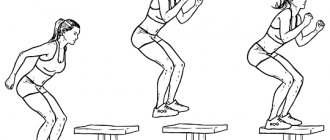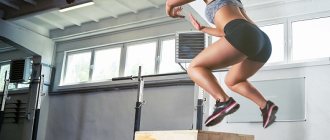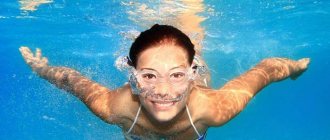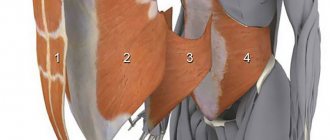Friends, good afternoon! We, the authors of the blog, the Valitov brothers, welcome all our readers to tell you on this page how to learn to do a standing long jump.
Since these jumps are necessary not only for athletes, as training exercises for the comprehensive development of their physical qualities, but for any person they also have their practical significance.
Practical skills and the ability to jump far can help people in any emergency life situation when it is necessary to jump over a hole, ditch, ditch, puddle or other obstacle.
This skill allows a person to develop his muscles, speed or strength capabilities.
What is special about the standing jumping process? How to correctly master the technique of performing them, and what additional training will allow a person to jump far from a place, but more on all this later.
Overview of muscle groups
The standing high jump is based on the force of the jump the body can make. To determine an exercise program, you need to understand which muscle groups are involved during a jump. First of all, these are the legs, or rather the calf muscles and quadriceps.
The front of the thigh is the largest muscle group. It is responsible for extending the leg and, therefore, pushing the body out of place. The calf muscle plays an equally important role in the jump. It’s not for nothing that boxers train their calves, because explosive power and punching power depend on the strength of their legs. The pushing occurs as if along a chain - ankle, lower leg, thigh. These muscle groups and ligaments should be developed first.
The main mistake any athlete makes when trying to increase their jump height is inattention to the stabilizer muscles. These are the muscles of the back and abdomen. In many manuals you can find recommendations for abdominal training. If your goal, as in this case, is to develop explosive muscle strength, daily exercise will not produce visible results.
What you need to know about the technique and the jump itself
In this chapter we will look a little at the technique and anatomy of this action.
To perform a jump, you need to apply both internal and external forces.
If we talk about external force, then gravity and also ground reactions have a strong influence. The first is valid in all phases, and the second only in the first, second and fourth.
Look at the picture, which shows each phase of the jump in detail and interestingly.
If this action is considered from the point of view of mechanics, theoretically of course, then the force of the push should be performed at an angle of 45 degrees to the horizon, since this is how the body moves in the free flight phase.
The support area changes in different phases. In the preparatory stage it is greatest; during the push it decreases, but by the end, that is, to the full landing, the area of support again becomes the same as at the beginning of the jump, since the jumper stands on both feet.
Thus, the stability of the body still depends on the support.
Next, we will consider the theoretical basis of the jumping technique.
Let's look at everything in more detail, that is, which muscles and joints help us with this.
In the first stage, it is necessary to prepare the motor system for an advantageous position.
For a stronger repulsion, the body should occupy a lower position at the beginning, and a higher one at the end. To do this, you need to stretch the muscles that carry it out.
In the first stage, the jumper is positioned in a squat position. The jump begins at the hip and knee joints. The torso is slightly tilted forward, the arms are slightly extended and laid back
The torso and head are held by the extensor muscles of the spinal column.
The squat position ensures subsequent push-off.
And so, let's move on to the second stage. This is where the push with both legs occurs. For a more even push-off, the feet should be parallel
When you push off, the ankle joint flexes, and the knee and hip joint also extend. Next, the jumper’s torso straightens, and a sharp swing of straight arms up increases repulsion.
We have looked at the second step; if you delve into it a little, it becomes clear that it helps us to jump far.
During the flight phase, you need to adopt a body position that promotes movement and proper landing.
That is, you need to bring your lower limbs forward. This is possible by tightening the hip flexor muscles.
When landing, the same muscles work as in the preparatory stage.
The third step is simpler, it is similar to the first, of course with its own nuances, but still not a big difference.
Don't forget about your breathing. It may not greatly affect the technique, but it is necessary to know how to breathe correctly.
This means that in the first phase you exhale, and when you land, you inhale.
Of course, what is written here may seem complicated, but this is a basic understanding of the performance, since knowing which muscles and joints are used in a given action, you can improve both the technique and the action itself.
Stop writing theory, which only confuses, let’s get down to practice, otherwise we’re probably already tired.
Read on for a more detailed description of each stage.
The necessary conditions
The best programs are offered by bodybuilders.
Workout 3-4 times a week so that the muscles have time to recover. In this case, you get the maximum effect without overtraining, muscle tension and wear. To achieve your highest standing high jump, you will have to pay close attention to it. Exercises to develop jumping ability should be performed systematically, without skipping and without concessions. In athletics, there are several types of high jumps, different in technique, but the same in results.
If the question is: “How to increase the high jump in volleyball or basketball?”, athletics terms should be left aside. Let's look at the basic exercises for everyday life and team sports.
Game to help
It is known that children learn best by imitating their parents and through play. Therefore, when teaching them to jump, you can ask them to pretend, like their mother, different animals or objects (ball, frog, bunny, peas, kangaroo, sparrow, grasshopper). At the same time, the sparrow jumps forward, the pea or ball jumps up, the frog can jump from a pebble into a swamp or jump to another pebble.
You can invite your child to catch toy butterflies, dragonflies while jumping, or to reach for objects in the hands of parents, to jump over “puddles”, “streams”, pebbles” drawn or imitated by toys, to jump over hoops, bright jump ropes or ropes.
Various poems, nursery rhymes (“My cheerful red ball”, “A sieve is jumping across the fields”), poems about frogs, sparrows, etc. can create a cheerful mood during classes. It is good to use the following words as illustrations: “jump-jump” , “from hummock to hummock”, “from leg to leg”.
More complex game options may consist of several actions. For example, when you hear the word “sparrow,” the baby jumps off the hill and jumps on the ground; when you hear the word “car,” you must return back. Or at the words “calm” he jumps into the “water” and plays, runs, at the word “storm” he comes back.
As the child gets older, he will be able to master jumping with crossed legs, running long jump, high jump, turning jump, jumping, jumping onto an elevated surface and other types of jumps. But you need to start with the simplest ones, appropriate to the age and physical shape of the child, gradually complicating the task. This is the main key to success.
Basic exercises
When asked how to increase your high jump in basketball or any other sport, every coach will answer: “Improve your overall physical condition.” And this will be the honest truth. To guarantee success, an athlete needs to be resilient, strong, and healthy. Against the background of general physiological well-being, exercises aimed at developing certain muscle groups are necessary.
Jumping rope
They are the most popular exercise in many sports areas. In boxing, for example, the jump rope is the main tool for developing muscle strength. Basketball players, volleyball players and gymnasts must include jumping rope in their training program. This simple and accessible element allows you to most effectively develop the calf and soleus muscles. Jump rope for 15-20 minutes a day, gradually increasing this time to half an hour. After 2-4 weeks you will notice significant improvements. To implement your plan to increase your jump height, push off the surface with both feet. Keep your ankles as close to each other as possible.
Squat
Squats are one of the main exercises in bodybuilding. Weighted squats develop all the muscles in your legs, abdominals, and lower back muscles. Thus, a single exercise allows you to strengthen all the muscle groups necessary for high jumps. Answering the question of how to jump higher in basketball, volleyball, and gymnastics, we suggest diversifying regular squats with the same push-up exercise. Squat down to a parallel line with the floor and jump up from this position with force. The main condition is that the landing time should be as short as possible. A large squat amplitude will help to maximize the use of all muscle groups of the legs. Do 10-15 squats, then break for 3-4 minutes.
Calf raises
Calf raises strengthen the calf muscles. This exercise must be done until the calves are completely burned. Do 20-30 repetitions at full amplitude. In the final phase of the exercise you should be standing almost on your toes. Then slowly lower back onto your heels. The exercise should be done without jerking. As your endurance increases, add weights. Pick up dumbbells or instead of regular lifts, switch to jumping on your toes.
Air Alert Exercise Program at Home to Increase Jump Height
The Air Alert program is designed to improve jumping ability. It was developed by TMT Sports.
The course lasts 15 weeks , during which the creators promise amazing results - an increase in jump height by 20-35 centimeters (depending on the characteristics of the body).
Mandatory conditions while working on the program are good and sound sleep , as well as proper nutrition.
Schedule
The program requires a serious approach and attitude to performing the exercises. To achieve positive results, you need to stick to your training plan and schedule. Air Alert is designed for almost 4 months (15 weeks), the regularity of exercises is 3 times a week.
Warming up before training
warm-up exercises for himself. The main goal is to warm up all muscle groups and prepare them for stress. Jumping rope and running in place are recommended. Approximate heating time is 3-5 minutes.
How to improve your stretching
Warming up your muscles is half the battle. It is even more important to stretch all the muscles involved in the exercise.
So, the calf muscles are stretched with exercises similar to step-ups (we put our foot on the stairs and try to reach the floor with our hand).
Photo 1. This is how an exercise to stretch the calf muscle is performed: the foot is placed on the platform, with your hand you need to reach the toe.
The anterior thigh muscle also needs stretching, for which we place our leg on a chair and stretch our body towards this limb.
The muscles under the knee can be stretched using the most common bends - simple and effective!
High jump:
- Place your feet shoulder-width apart.
- Jump up as far as you can.
- When landing, squat down to about a quarter.
The main thing with this exercise is the speed of the jump. The point is to jump out as quickly and often as possible. Spending a split second will make sense. The person should feel the anterior thigh muscle tightening more than the calves.
Important! When jumping and landing, your knees should not bend.
Calf raises:
- Stand on some kind of elevation (like a thick book), your heels should not touch the ground.
- First, “reach for the stars” on the toe of one foot , then use the other limb.
- Between approaches, rest no more than 25-30 seconds.
Decisive factors
Strength training and a healthy lifestyle are the basis for increasing your jump height.
If you are seriously thinking about how to develop jumping ability, then you should take into account all the components of the effectiveness of exercises:
- Regularly visiting the gym will help significantly improve your performance.
- Proper nutrition and healthy sleep are the basis for muscle recovery and strengthening.
- Logging progress. Mark your jump height once a month to evaluate the results of your work.
The most important thing: high jump exercises should follow a thorough warm-up and warm-up of the muscles. This is the only way to avoid injury. Allow 10 to 20 minutes to warm up. This should be followed by stretching of all muscle fibers, and only then the main workout.
By doing this program 3-4 times a week without skipping or making excuses, within a month you will notice significant progress and be able to jump much higher than before.











